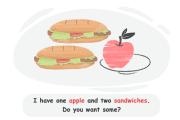Countable and Uncountable Nouns For beginners
Learn to distinguish between countable nouns (like 'apple') and uncountable nouns (like 'water'). Simple explanations, examples, and exercises included.

What Are Countable Nouns?
Nouns that can be counted and used with a number are known as countable nouns. Countable nouns have both singular and plural forms. For example:
1 apple, 2 apples
15 cats
3 dogs
1 car
2 spoons
Take these apples.
Give me a pen.
I need five more balls.


What Are Uncountable Nouns?
Uncountable nouns cannot be counted and therefore only have a singular form. Also, they cannot be used with numbers.
butter (Not 1 butter)
rice (Not 2 rices)
honey (Not 3 honeys)
My hair is dark.
I'm eating bread and butter.
Verb Agreement
Keep in mind that uncountable nouns are always used with singular verb forms. Here are some examples:
My hair is growing.
The jam was sweet.
Money doesn't buy happiness.
Common Uncountable Nouns
Here is a list of common uncountable nouns:
water
air
sugar
tea
rice
butter
milk
rain
weather
money
Asking about Countable and Uncountable Nouns
When forming questions, how many is used with countable nouns, and how much is used with uncountable nouns. For example:
How many chairs are there?
How much juice is there?
Quiz:
Which sentence correctly uses an uncountable noun?
Please give me a tea.
I bought some sugar.
I bought five butter.
I washed my hairs.
Complete the table by choosing the correct word: countable or uncountable.
| noun | type |
|---|---|
book | |
rice | |
orange | |
chair | |
bread | |
mouse |
Which sentence uses the correct verb form with an uncountable noun?
The bread are on the table.
The money were lost.
The sugar is sweet.
The water are cold.
Complete each sentence by choosing the correct word.
Can you give me
water to drink?
apples are there in the basket?
We saw
children playing in the park yesterday.
jam is left in the jar?
Comments
(0)